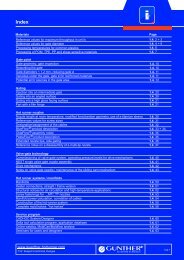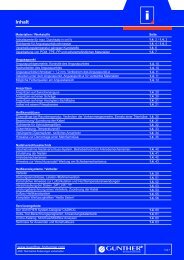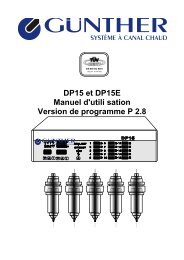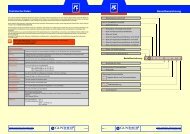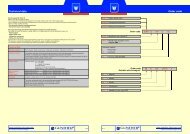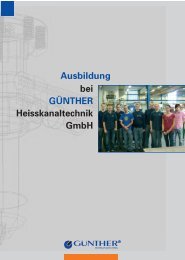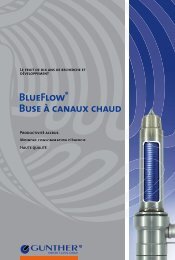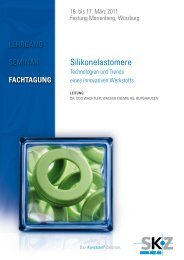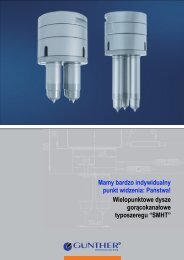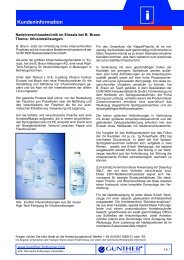Heißkanaldüsen Typ SLT/-DLT Customer information
Heißkanaldüsen Typ SLT/-DLT Customer information
Heißkanaldüsen Typ SLT/-DLT Customer information
You also want an ePaper? Increase the reach of your titles
YUMPU automatically turns print PDFs into web optimized ePapers that Google loves.
<strong>Heißkanaldüsen</strong> <strong>Customer</strong> <strong>information</strong> <strong>Typ</strong> <strong>SLT</strong>/-<strong>DLT</strong><br />
Nozzle design for injection moulding on tandem tools<br />
50% of cycle time can be saved by switching from<br />
standard injection moulding production to tandem<br />
technology. A precondition here is the ideal adaptation of<br />
the melt flow path and the nozzles to suit the altered<br />
process. To produce glass-fibre reinforced polyamide<br />
covers, GÜNTHER Hot-Runner Engineering developed<br />
within a very short time a nozzle construction that offered<br />
the advantages of low costs, reliable heat management<br />
and easy installation.<br />
Objectives which even in normal economic circumstances<br />
would rank among the most important for a new<br />
process are of particular significance in times of crisis.<br />
These are to manufacture components in as short a time<br />
as possible and at costs as low as possible. The fact that<br />
tandem technology in injection moulding can reduce<br />
cycle time by up to 50% induced a major German<br />
manufacturer of motor tools to change over to this technology<br />
for the production of glass-fibre reinforced<br />
polyamide covers for work tools. Tandem technology<br />
makes use of the unproductive cooling time in injection<br />
moulding. Ideally this doubles the output from a standard<br />
machine. The process runs as follows: after closing the<br />
first parting level of the mould and injecting the melt, the<br />
second parting level opens during the cooling process,<br />
the parts fall out of the mould, the parting level closes and<br />
the melt is injected. While the components are cooling in<br />
the second level, work can be continued in the first level.<br />
The advantages for the process of this overlapping are<br />
shorter time requirements and lower costs.<br />
Fig. Mould with tandem technology: One challenge is the melt flow<br />
path from the first to the second parting level.<br />
www.guenther-hotrunner.com<br />
7/12 Subject to technical changes<br />
iA<br />
Before the process changed over to this technology the<br />
assembly, which consisted of two differently-sized<br />
components, was produced on two injection moulding<br />
machines in two different moulds. In tandem technology<br />
the production of the assembly could be combined in one<br />
mould so that there was no longer any need for a second<br />
machine.<br />
Keeping mould costs low<br />
To implement the technology, the injection moulder got in<br />
touch with T/Mould GmbH & CO KG, Bad Salzuflen, the<br />
sole supplier of tandem technology, at the beginning of<br />
2008. “A major challenge presented by such a project is<br />
to keep tool costs as low as possible”, explains Daniel<br />
Gersmann, who is the supplier's Project Consultant.<br />
“In the current project the main challenges were the<br />
design of the nozzle and melt flow path. The tandem<br />
technology side of the project did not present any great<br />
problems because the component geometry is relatively<br />
simple.”<br />
To find the best solution, injection moulders and suppliers<br />
of tandem technology drew on the know-how of Günther<br />
Heisskanaltechnik GmbH in Frankenberg (Eder). The<br />
hot-runner specialist developed a system for the<br />
application in which the functionality of the complete 2+2cavity<br />
mould could be produced with two nozzles. The<br />
alternative to this would have been a more complex hotrunner<br />
system with main manifold and sub-runners for<br />
injection for both components. The simple layout<br />
reduced the costs of the nozzle construction by more<br />
than half compared to the redirection system.<br />
Combination of hot-runner and cold-runner technology<br />
“Looking back, we actually built the system twice”,<br />
remembers Carlo Rasi, sales representative for the<br />
Frankenberg hot-runner specialist. “The first solution<br />
comprised a large hot-runner system with which the melt<br />
was conducted through main manifolds and sub-runners<br />
to the hot-runner nozzles; the transfer nozzle was<br />
constructed as a valve gate nozzle.” The original idea<br />
was that in addition to the nozzle in the first level, two<br />
nozzles with their heads lying against each other would<br />
be used in the second level. “However, this solution not<br />
only required a larger mould but also a larger injection<br />
moulding machine and would accordingly have<br />
increased costs. Furthermore”, continues Rasi “such a<br />
solution would not have been ideal because of the heat<br />
loss.”<br />
For any questions, please contact our Application Engineering department at + 49 (0) 6451 5008-31 or -63.<br />
The <strong>information</strong> is given in accordance with our present-day knowledge and is meant to provide technical background.<br />
1.5. 24



